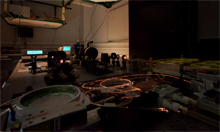Fiber lasers have become commonplace in systems for a wide range of uses such as in medical applications, manufacturing workstations, and telecommunications equipment. During the last ~30 years fiber laser sources have been predominately based on ytterbium and erbium dopant ions. Starting in 2006, the Laser Plasma Laboratory (LPL) joined the rapidly growing effort to develop thulium doped fiber lasers. Since that time, LPL and the Townes Laser Institute have invested significantly developing capabilities, facilities, and expertise to make the University of Central Florida an academic leader in optical fiber and fiber lasers. Within LPL, the Fiber Laser Laboratory brings together the Fiber Processing, 2 um Laser Propagation, Thermal Lens Characterization facilities.
We currently have projects pushing the limits of Tm:fiber lasers in CW, nanosecond and femtosecond configurations. We seek to take advantage of the established benefits of fiber laser architecture, such as improved thermal management and modular system design, and optimize systems for operation in the 2 um wavelength range. Tm:fiber laser technology is still relatively immature and developing rapidly. Particularly in high peak power pulse generation, Tm:fiber has great promise that is yet to be realized.
Tm:fiber laser development also provides a “stepping-stone” for mid-IR laser development. Many of the diagnostics for 2 um are also appropriate for wavelengths up to 5 um. Tm:fiber lasers providing efficient pumping of Ho:YAG, Cr:ZnSe/S and Fe:ZnSe solid-state laser media. Finally, short and ultrashort pulse Tm:fiber lasers are capable of efficiently mid-IR generation by pumping optical parametric oscillators/amplifiers or supercontinuum generation.

